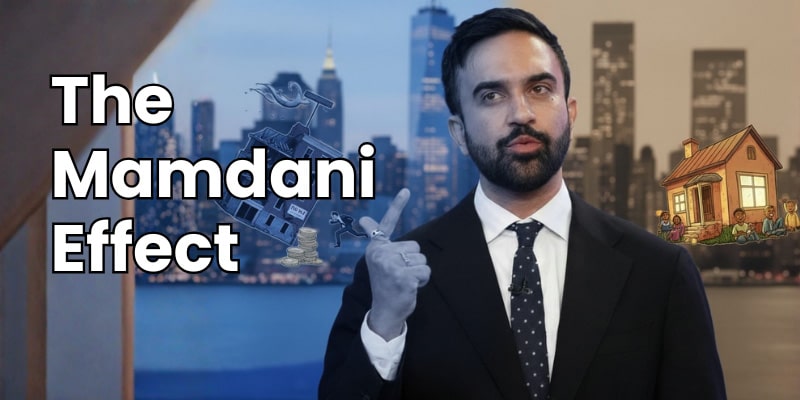
The Mamdani Effect: How New Mayor Zohran Mamdani Could Reshape New York Real Estate
New York City has a new mayor, and the real estate industry is holding its breath. The election of Zohran Mamdani, a Democratic Socialist and outspoken housing activist, represents one of the most significant political shifts in the city's modern history.
Mamdani ran on an aggressive affordability-first platform, framing housing not as a commodity but as a human right. For millions of tenants, his victory signals a new era of stability and protection. For the real estate industry, it signals a five-alarm fire.
Billionaire real estate investor Barry Sternlicht, CEO of Starwood Capital Group, issued a stark warning, claiming Mamdani's policies could "turn New York City into Mumbai," with "rotting" buildings due to a lack of landlord incentive.
Is this hyperbole, or is the NYC real estate market on the brink of a radical transformation? This article breaks down Zohran Mamdani's key policies and their potential effects on every corner of the market.
Who is Zohran Mamdani?
First, it's crucial to understand who the new mayor is. Zohran Mamdani is not a traditional politician. He's a former housing counselor and a prominent member of the Democratic Socialists of America (DSA). He was elected on a wave of support from renters and younger voters exhausted by the city's affordability crisis.
His platform is a direct challenge to the real estate lobby's decades-long influence in city politics.
Mamdani's Core Housing Agenda: The 3 Key Policies
Mamdani's plan isn't just one bill; it's a multi-pronged strategy to re-engineer the city's housing market.
1. The Rent Freeze
This is the flagship promise. Mamdani has pledged to immediately freeze rents for all rent-stabilized apartments—a move that would affect nearly one million units and over two million residents.
-
How he'll do it: The mayor cannot freeze rents with a magic wand. Instead, he has the power to appoint all nine members of the Rent Guidelines Board (RGB), the body that votes on annual increases. Mamdani has vowed to appoint a board composed entirely of members who will vote for a 0% increase, effectively enacting his freeze.
2. Backing "Good Cause Eviction"
While Mamdani was campaigning, New York State passed the "Good Cause Eviction" law, which now applies to New York City. This law is a cornerstone of his political vision. It:
-
Prevents Evictions: Landlords can no longer refuse to renew a lease without a "good cause," such as non-payment of rent or property damage.
-
Caps Rent Hikes: It effectively limits rent increases on market-rate apartments, giving tenants the right to challenge "unreasonable" hikes in court.
3. A New Wave of Affordable Construction
Mamdani's plan isn't just about regulation; it's also about building. He has pledged to:
-
Build 200,000 new, "truly affordable" rent-stabilized homes over the next 10 years.
-
Prioritize Union Labor for all major construction projects (over $100 million).
-
Crack down on "bad landlords" who have numerous housing code violations.
The Impact: What Happens to the NYC Market?
This is where the battle lines are drawn. The "Mamdani Effect" will create clear winners and losers.
For Landlords & Developers: A "Chilling Effect"
The real estate industry is warning of catastrophic consequences.
-
The "Mumbai" Scenario: Barry Sternlicht's warning is that if landlords can't raise rents to cover rising costs (insurance, property taxes, repairs), they will let their buildings fall into disrepair. This could be especially true for "mom-and-pop" owners who rely on rent from a single stabilized building.
-
Investment Evaporation: Developers argue that a combination of rent caps and union-labor mandates makes new construction "economically unfeasible." The fear is that developers will stop building new housing, which would worsen the city's housing supply shortage and drive up prices for non-regulated units.
-
Capital Flight: The reaction has been national. Real estate professionals in South Florida are reportedly preparing for a new wave of capital and wealthy residents fleeing New York's hostile business environment. One developer even told a forum he hoped Mamdani would "end the city" so he could "pick up all the pieces at a very low price point."
For Tenants: A "Bedrock of Security"
For renters, especially the two million in stabilized units, Mamdani's policies are a lifeline.
-
Unprecedented Stability: A rent freeze and "Good Cause Eviction" would mean an end to the fear of sudden, massive rent hikes or arbitrary non-renewals.
-
More Bargaining Power: Tenants will be more empowered to request repairs or organize, knowing they are protected from retaliatory evictions.
-
The "Market-Rate" Irony: Here's the catch. Some experts warn that Mamdani's policies may not help market-rate tenants. In fact, they could inadvertently hurt them. If a landlord owns a building with both stabilized and market-rate units, they may dramatically increase rents on the market-rate units to compensate for the freeze on the stabilized ones.
⚖️ Conclusion: A High-Stakes Bet on Two Competing Visions
The clash between Zohran Mamdani and the real estate industry is more than a political fight; it's a battle for the soul of New York.
Mamdani's vision is a city where housing is a secure, affordable right for all, funded by taxing the wealthy and regulating corporate landlords.
The industry's vision is that housing is an asset, and only a free, profitable market can incentivize the construction needed to solve the supply crisis and make the city affordable.
The world is now watching to see which vision is right. The outcome will not only determine the future of New York's skyline and rent checks but will also set a precedent for every major city grappling with an affordability crisis.
